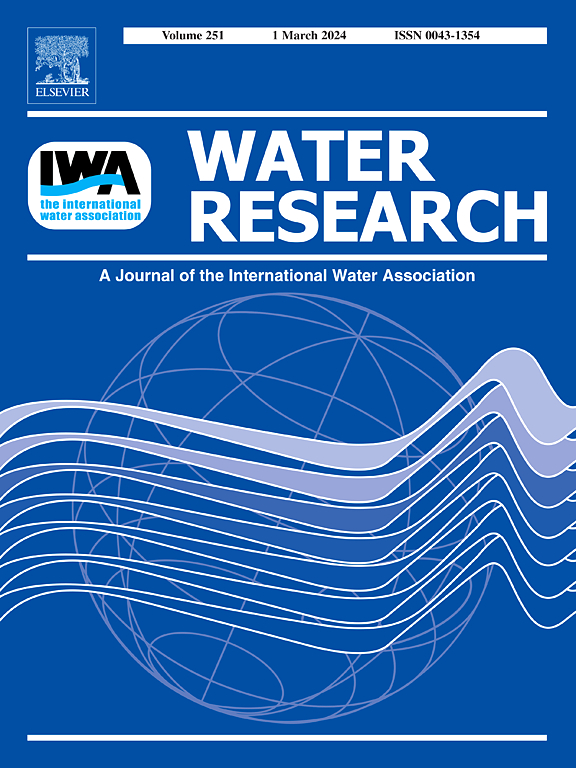A quantitative microbial risk assessment framework for cholera infection from post-flood ponds
IF 12.4
1区 环境科学与生态学
Q1 ENGINEERING, ENVIRONMENTAL
引用次数: 0
Abstract
Floods are the most common type of natural disaster worldwide and have substantial socioeconomic and environmental impacts, including public health effects. Exposure to floodwaters containing pathogens poses risks to infectious diseases such as cholera, leading to diminished well-being and even loss of life. Accra, the capital of Ghana, has a long history of flood events and cholera outbreaks. Post-flood periods have the potential for transmission of water-borne diseases with significantly higher cholera risk. This study aims to assess the health risks associated with Vibrio cholerae pathogens after flood events and evaluate their impacts on Accra’s population, focusing on Alajo, a neighbourhood in Accra. A post-flood pathogen (SPATE) model was developed, integrating hydrological processes (evaporation and infiltration) and pathogen decay rate, to simulate the spatial temporal distribution of floodwater ponds and the V. cholerae concentrations therein. The infection probability was calculated with the quantitative microbial and flood risk assessment. After flooding, the risk of V. cholerae infection tends to be higher in scattered ponds near the drainage network, surrounding areas of the Onyasia river, and the urban area northeastern of Alajo. The peak risk of V. cholerae infection occurs within the first 12 h post-flooding, declining rapidly thereafter. Variations in infection probability and flood exceedance probability are observed across the area, with an overall trend of reduced infection probability with increasing return periods. Notably, children engaging in water activities face higher risks compared to adults wading in post-flood waters. These findings contribute to decision-making in flood risk management and health risk assessment, facilitating prioritization of vulnerable areas and resource allocation to mitigate and prevent the health impacts of flooding, considering explicitly for the time after flooding when the risk remains elevated.
洪水后池塘霍乱感染的定量微生物风险评估框架
洪水是世界上最常见的自然灾害类型,具有重大的社会经济和环境影响,包括公共卫生影响。暴露于含有病原体的洪水对霍乱等传染病构成风险,导致福祉下降,甚至丧失生命。加纳首都阿克拉在洪水事件和霍乱爆发方面有着悠久的历史。洪水后时期有可能传播水媒疾病,霍乱风险明显较高。该研究旨在评估洪水事件后与霍乱弧菌病原体相关的健康风险,并评估其对阿克拉人口的影响,重点是阿克拉的Alajo社区。建立了综合水文过程(蒸发和入渗)和病原体衰减率的洪水后病原体(洪水后病原体)模型,模拟了洪水塘的时空分布和其中的霍乱弧菌浓度。通过定量微生物和洪水风险评估计算感染概率。洪水发生后,分布在水系附近的散乱池塘、Onyasia河周边地区和Alajo东北部城区的霍乱弧菌感染风险较高。霍乱弧菌感染的风险高峰发生在洪水后的头12小时内,此后迅速下降。感染概率和洪水泛滥概率在整个区域都有变化,随着回归期的增加,感染概率总体呈降低趋势。值得注意的是,从事水上活动的儿童比在洪水后涉水的成年人面临更高的风险。这些发现有助于洪水风险管理和健康风险评估的决策,促进脆弱地区的优先排序和资源分配,以减轻和预防洪水对健康的影响,明确考虑洪水后风险仍然较高的时间。
本文章由计算机程序翻译,如有差异,请以英文原文为准。
求助全文
约1分钟内获得全文
求助全文
来源期刊

Water Research
环境科学-工程:环境
CiteScore
20.80
自引率
9.40%
发文量
1307
审稿时长
38 days
期刊介绍:
Water Research, along with its open access companion journal Water Research X, serves as a platform for publishing original research papers covering various aspects of the science and technology related to the anthropogenic water cycle, water quality, and its management worldwide. The audience targeted by the journal comprises biologists, chemical engineers, chemists, civil engineers, environmental engineers, limnologists, and microbiologists. The scope of the journal include:
•Treatment processes for water and wastewaters (municipal, agricultural, industrial, and on-site treatment), including resource recovery and residuals management;
•Urban hydrology including sewer systems, stormwater management, and green infrastructure;
•Drinking water treatment and distribution;
•Potable and non-potable water reuse;
•Sanitation, public health, and risk assessment;
•Anaerobic digestion, solid and hazardous waste management, including source characterization and the effects and control of leachates and gaseous emissions;
•Contaminants (chemical, microbial, anthropogenic particles such as nanoparticles or microplastics) and related water quality sensing, monitoring, fate, and assessment;
•Anthropogenic impacts on inland, tidal, coastal and urban waters, focusing on surface and ground waters, and point and non-point sources of pollution;
•Environmental restoration, linked to surface water, groundwater and groundwater remediation;
•Analysis of the interfaces between sediments and water, and between water and atmosphere, focusing specifically on anthropogenic impacts;
•Mathematical modelling, systems analysis, machine learning, and beneficial use of big data related to the anthropogenic water cycle;
•Socio-economic, policy, and regulations studies.
 求助内容:
求助内容: 应助结果提醒方式:
应助结果提醒方式:


